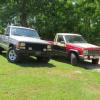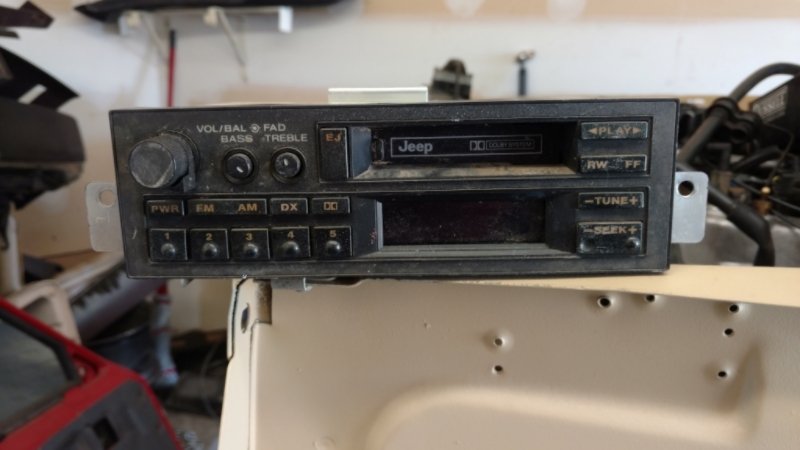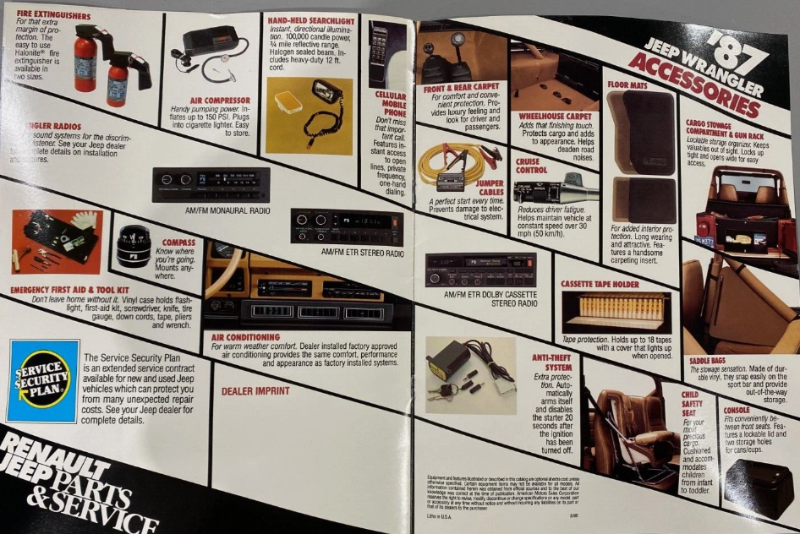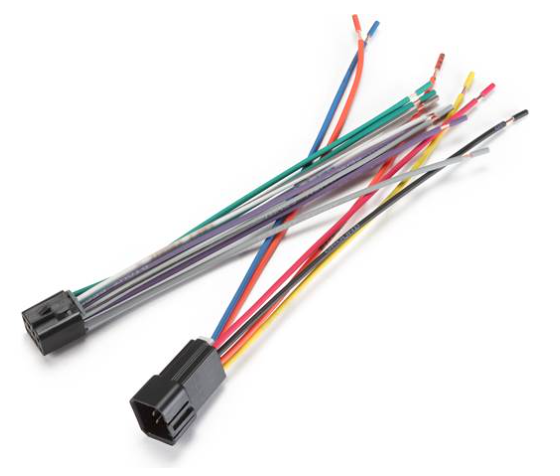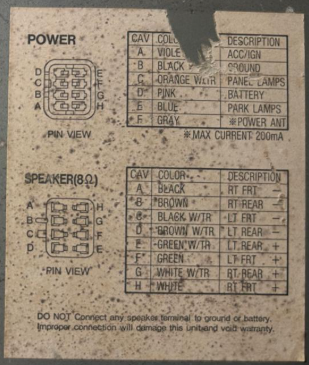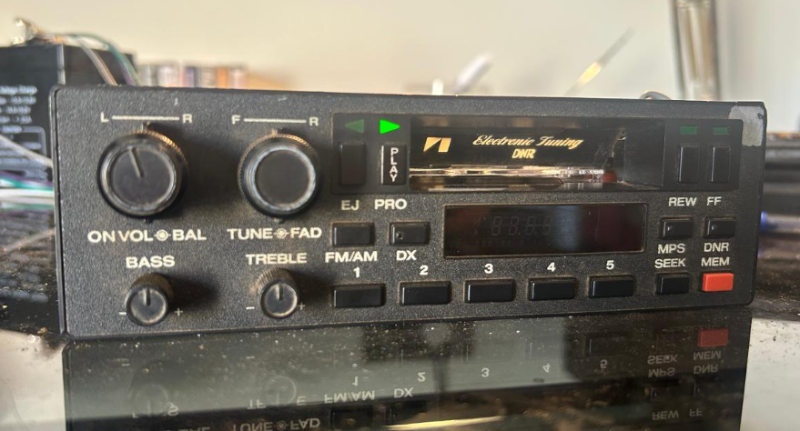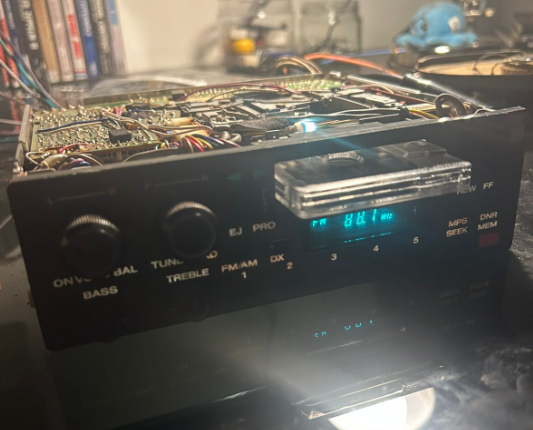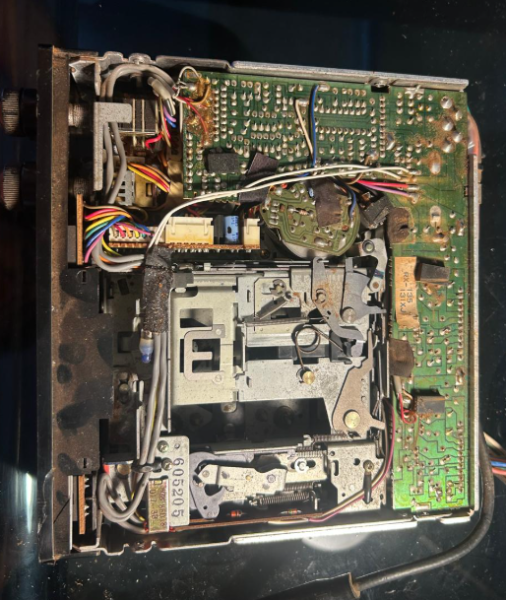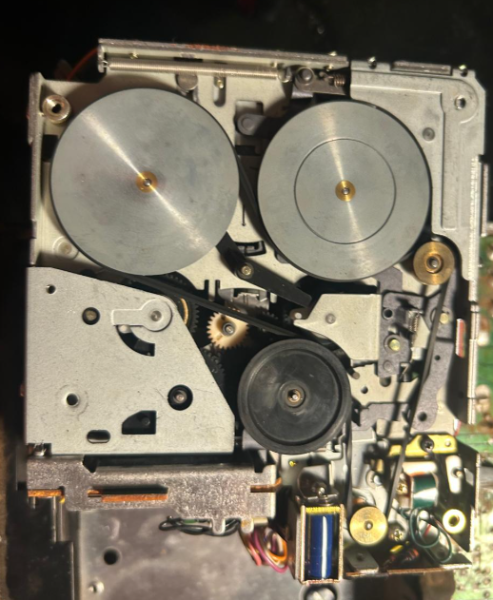Search the Community
Showing results for tags 'factory radio'.
-
What Minuit Knows About Stock Jeep Radios Got a question? Need one of these radios repaired, or want to buy one? Check out my website! What is this? Simply put, it's a compilation of my findings regarding the factory radios installed in Jeeps 84-96 with a focus towards those that can be installed in Comanches. How come there's a link to a business website at the very top of what's supposed to be an informational write-up? Is this just a disguised ad for a business you own? No. This writeup came long before any money changed hands, but after a while members of this community began asking me to repair and upgrade their radios. A warning in case you want to poke inside. First of all, most of these radios are made in Japan. The many "Philips" screws on them are in many cases Japanese Industrial Standard (JIS) fasteners. These screws are usually marked by a circular divot in the head of the screw. A typical Philips screwdriver will ruin these screws very easily. A screwdriver that specifically states it works with JIS screws is highly recommended if you want to play around with these radios. I have been extremely impressed with my set of Vessel screwdrivers made in Japan. JIS screwdrivers often make better Phillips screwdrivers than actual Phillips screwdrivers, too. What Will Fit? Let's get this out of the way. Every single radio I discuss in this article will physically fit in the dashboard of any Jeep XJ Cherokee/Wagoneer or MJ Comanche from 1984-1996. The dashboard opening never changed until 1997. These will also fit in right hand drive Jeep Cherokees. All radios featured in this article have detachable mounting brackets to allow installation in different vehicles. Mounting brackets are available to mount factory Jeep radios in the following vehicles: -1984-1996 Jeep XJ Cherokee/MJ Comanche -1985-1991 Jeep SJ Grand Wagoneer -1987-1995 Jeep YJ Wrangler -1985-1987 AMC Eagle -1988-1992 Eagle Premier/Dodge Monaco -1985-1987 Renault Alliance/Encore These will not fit under any circumstances - Any radio larger than the DIN standard size, including most Chrysler radios - CJ shaft style radios unless using a Metra 87-15-1007 kit, which supports certain shaft radios. Vehicle connections differ between the 3 eras. Chrysler and Late AMC era radios should have labels somewhere on them showing the connector pinouts, but they are sometimes missing or unreadable. Please note that the year splits given are a general rule, not set in stone! I have seen pictures of brand new 1989 year trucks with AMC radios in them, for example. Early AMC Era (??-1984) You're on your own. Information about these is very hard to come by. Connectors change every few years, and most use a "common ground" style of speaker setup. 1984-1985 The 1984 and 1985 lineup of AMC radios is weird. Identical to their later versions when installed in a car, but they have significant internal and wiring differences. Most notably, they feature as many as 4 individual, small connectors for different functions. I do not recommend purchasing these on this basis, but these radios can be re-wired to match the more adaptable Late AMC Era connection style. Certain internal differences make some of these radios (especially the RX-141) more difficult to repair. Stereo 1985 radios use a "common-negative" style of speaker connection, with the negative signal shared between the front and rear speakers of each channel. Mono units instead ground the negative side of the speaker. Late AMC Era (1986-1987) Late AMC Era radios have 2 8-position, free hanging connectors with some pins not used. The male connector carries speaker signals, and the female connector powers the radio. The radio will function with the "speaker" connector unplugged but will not produce sound. All late AMC era radios have identical connector pinouts, but depending on the model some pins are not used. Do not rely on color to determine the function of the wire. Pins are labeled with letters on the connectors themselves - a very intuitive setup. When buying a radio, keep in mind that in the AMC era, having 4 speakers was a somewhat rare option. Not all radios are pinned for all 4 speakers! If the radio has a "fade" control, it is equipped to drive 4 speakers. Stereo radios of this era use conventional speaker connections, with balanced + and - terminals. Mono radios continue to ground the negative speaker terminal. http://i.imgur.com/UMlZMwUl.gif The diagram is drawn looking into the front face of the connector. Chrysler Era (1988-1996) All Chrysler era Jeep radios use a 13-pin connector, which almost always plugs directly into the radio. Some very, very early Chrysler era radios have a free-hanging connector, but you are not likely to find this. Almost all Chrysler era radios have all pins present for 4 speakers and a power antenna regardless of whether or not the vehicle had them. If the vehicle the radio was originally installed in only had 2 speakers, a jumper harness was usually used. Speaker connections are completely conventional, with + and - balanced connections. http://i.imgur.com/luIPdFFl.jpg The diagram is drawn looking into the radio's connector. Aftermarket harnesses: Metra 70-1002 Metra 71-1002 The Radios This section is for information on the individual decks within the scope of this writeup. The information given (if it is available) will be as follows: - The deck's part number (and manufacturer number if known). The part numbers may differ based on the vehicle the radio was originally installed in - the part numbers given are for XJ and MJ applications. - Pictures of the deck at night, and in daylight if available. - Radio type - Display type - Years offered in Jeep vehicles - Manufacturer - Power output if known. Sometimes, the datasheets for internal amplifiers are available, and measurements are given if known. Otherwise, I will make a guess as to its power. - Aux input compatible? With some creativity all radios are capable of accepting an auxiliary input, but radios that have "Yes" marked accept it more easily, typically by applying a stereo signal to easily accessible test points. If soldering is required, "aux input compatible" is not marked. - Distinguishing features - Pros - Nice things about the deck. - Cons - bad features of the deck not counting any problems. - Common problems, and the causes, if known. Early AMC Era (??-1984) The wild west, as far as this writeup (which is intended to roughly cover the lifetime of the XJ Cherokee until 1996) is concerned. I currently have no information on the connectors used, and a dizzying array of different twin-shaft style radios were used. This was the very beginning of the digital tuning era, and radios older than 1984 are far out of my area of expertise. 3238861 / 8936000033 Type: AM/FM/Cassette Display: Vacuum fluorescent Years: 1983-1985 Manufacturer: Mitsubishi Power: 13Wx2 RMS at 8 ohms. Features: 5 station memory per band Compatible with four speakers Mechanical tape loading and ejection, using the same design as the RX-141 and RX-161. Pros: - A shaft radio with surprisingly good specs, equivalent to the RX-161. - The internal circuitry seems quite repairable, although it is very tight due to the small chassis. Cons: - Common-negative speaker wiring (negative wire shared between front and rear speakers of each channel) - Uses entirely different connectors than later radios. - Shaft mounting, so an adapter plate will need to be used to install it in a later dash. Not considered worthy of an actual model name for some reason, the 3238861 is what you get when you put an RX-161 into a hydraulic press and smash it until it's as small as it can possibly be. This is the radio used in the 1984 and 1985 Grand Wagoneer, and was optional on the AMC Eagle and various other AMC and Renault products. By this point, the twin shaft style of chassis was being stretched to its limits, and it shows. This isn't your daddy's mono AM shaft radio, and I suspect one in good working order will make you quite happy. This one won't fit in your MJ, though, unless you come up with an adapter to mount it in the dash. Late AMC Era (1985-1987) This is where things start to get good. The Late AMC Era radios are extremely well made, durable, and may surprise you with their sound quality. The cassette decks are also extremely heavy. Power is still lacking by modern standards, and they were teamed up with 8 ohm speakers from the factory. As a rule none of these radios have a clock. Internally these radios are very intricate and difficult to service. These aren't unique to Jeeps. They can also be found in AMC's other products, including Renault cars and the AMC Eagle. Don't believe me? Search "Renault Alliance interior" on Google images and you'll find several pictures of French cars with these very same radios in them. It might sound like there's a lot of downsides, but these radios sound good, look proper in our trucks' interior, and have an '80s retro charm that nothing else does. The 1985 versions are unique as described above. These differences lie primarily in their connection methods. A dizzying array of radios were offered in this period. AM only, AM-FM with either 2 or 4 speakers and with or without electronic tuning, and 2 different cassette decks were offered. RX-135 / RX-131 8956001651 / 8936001522 / 8936001268 Type: AM/FM/Cassette Display: Vacuum fluorescent, green or light blue Years: 1985 (RX-131), 1986-1987 (RX-135) Manufacturer: Mitsubishi Power: 13Wx2 RMS at 8 ohms. Features: Motorized tape ejection Dynamic Noise Reduction Music Program Search (MPS) - finds individual tracks on cassettes Seek sensitivity (DX) 5 station memory (per band) Pros: - Vacuum fluorescent display! - Very good sound quality, especially for the time Cons: - Exceptionally rare - These are getting very old, and will probably require service - Does not use the Jeep/Eagle factory connector - uses two separate plugs for power and speakers, so an adapter will need to be made to install this into a post-1987 vehicle. The RX-135 was the most technologically impressive of the AMC era radios, and is one of the very rarest. Its most distinctive feature is its noise reduction system, as indicated on the cassette door: it uses National Semiconductor's Dynamic Noise Reduction. Similar in nature to the far more common Dolby-B noise reduction system but much different in operation, DNR is also available when listening to AM and FM radio. These radios do not appear to have been common even when new. They are extemely scarce on the market today, especially in good condition. They show up as original equipment in Jeeps very infrequently, more commonly found in the Renault Alliance and similar vehicles. They may have been used into Chrysler's ownership period - notably, I have seen one installed in a brand new Comanche in a 1989 Jeep dealer training brochure. The unit pictured to the right was installed in a 1986 Jeep Comanche, but I have doubts that it was original. A very helpful member at ComancheClub.com spotted it in a junkyard. I am currently working on repairing it to full function. Like all AMC radios, the RX-135 remembers station presets even if the battery is disconnected. My testing has shown that the radio will remember stations for as much as 12 hours with no power, possibly longer. RX-161 / RX-141 8956001910 / 8956002148 / 8956002197 http://i.imgur.com/sqMeHVtl.jpg Type: AM/FM/Cassette Display: Vacuum fluorescent, light blue Years: 1984-1985 (RX-141), 1986-1987 (RX-161) Manufacturer: Mitsubishi Power: 13Wx2 RMS at 8 ohms. Features: Dolby-B Noise Reduction Seek sensitivity (DX) 5 station memory (per band) Pros: - Vacuum fluorescent display! Cons: - Rare - These are getting very old, and will probably require service - Does not use the Jeep/Eagle factory connector - uses two separate plugs for power and speakers, so an adapter will need to be made to install this into a post-1987 vehicle. The counterpart to the RX-135. It seems to appear more frequently in Jeeps, and is more traditional overall. It offers fewer features than the RX-135, lacking track searching, motorized cassette ejection, and forgoing DNR in favor of the much more common Dolby noise reduction. These radios are by no means common, but appear to be much more common in Jeeps. I have seen these radios in all Jeep products of this time, including Grand Wagoneers, highly optioned Cherokees, 1987 Wranglers, and Comanches. This radio appears to have co-existed with the RX-135. My 1987 Jeep Trucks brochure includes both as optional extras. In the Grand Wagoneer, this seems to be the only radio offered between 1985 and 1987, and possibly later depending on supply. The 1985 version of this radio is unique, with different connections. Its model designation is the RX-141. Like all AMC radios, the RX-161 remembers station presets even if the battery is disconnected. My testing has shown that the radio will remember stations for as much as 12 hours with no power, possibly longer. AR-7650 8956001384 / 8936001127 / 8936001521 / 8956001573 http://i.imgur.com/y5xR5Aal.jpg Type: AM/FM Display: Vacuum fluorescent Years: 1986-1987 Manufacturer: Mitsubishi Power: 13Wx2 at 8 ohms. The circuitry is perfectly stable at 4 ohms, but this unit does not have an external heat sink so heat is a concern. Distinguishing features: - Larger than usual vacuum fluorescent screen is located on the top right corner. - No clock, like other AMC units. - Seek mode works in both "directions" Pros: - Vacuum fluorescent display! Cons: - Rare - Does not use the Jeep/Eagle factory connector - uses two separate plugs for power and speakers, so an adapter will need to be made to install this into a post-1987 vehicle. - Overheating is a potential concern when running 4 4-ohm speakers. With electronic tuning, 4-speaker output, station memory, and bi-directional seeking, the AR-7650 is the most advanced non-cassette AMC radio. As indicated by the very wide variety of part numbers, this radio was used in a large number of different products. These radios can be found in any AMC product during their time period, and are among some of the most common AMC radios, although they are by no means common. These can be found with a number of logos printed on the screen. I have seen the pictured AMC logo, the Jeep logo, and the Renault logo on these units. I have briefly used the pictured example in one of my Comanches, and it made a good impression, with good sound quality (as good as one can get with 27 year old base model speakers, anyway) and a clean, attractive look. AR-7600 8956001980 / 8956001843 / 8982200408 / 8936001430 / 8936001520 Type: AM/FM Display: Mechanical tuning dial Years: 1986-1987 Manufacturer: Mitsubishi Power: 13Wx1 RMS at 8 ohms. Features: 5 station memory Manual AM and FM tuning Tone control Pros: - Very good AM and FM reception - Uncomplicated, and easy to keep running Cons: - Mono sound only, and the speaker connector is only pinned up for two speakers - Grounded negative speaker terminal (+ signal and ground, rather than + and - signals). - Does not use the Jeep/Eagle factory connector - uses two separate plugs for power and speakers, so an adapter will need to be used to install this into a post-1987 vehicle. The AR-7600 is fairly common by the standards of AMC radios, but in 2019 there aren't many reasons other than nostalgia to install one in your vehicle. This radio was used as one of the base options in just about everything AMC was shoving DIN-sized radios into, and is quite easy to find on the used market. If you want the best possible FM reception, this seems like a good candidate. Without any antenna plugged in, I could still pick up radio stations from surprisingly far away easily using this radio. Plus, it's just fun to use. The radio presets are stored mechanically - pull the button out and push it back in to save the current station. One fringe benefit of mechanically tuned radios is that they can pick up any radio station from 530-1610 kHz and from 88-108 MHz, no matter what frequency. This may be of interest in Europe, as most European countries have more closely spaced radio stations than North America. Chrysler Era (1988-1996) Just before Chrysler purchased American Motors Corporation in 1987, Mitsubishi and Automatic Radio Corporation developed a new generation of radio head units for the various Jeep vehicles being introduced and updated. The result was a significant technological improvement over the previous AMC radios. Specs are improved across the board, with better AM-FM reception, more power, improved reliablility, and one massive improvement: common use of 4-ohm speakers. These new radios did away with the flashy '80s look of the previous models, and introduced a black, businesslike aesthetic that still looks relatively modern. For the most part, these radios are exclusive to Jeeps. Certain models can also be found in the Eagle Premier. The Chrysler era head units, with their grown-up, businesslike look, represent the overwhelming majority of the available factory Jeep radios. A large variety of functionally equivalent units are available, and all share the same functional features. All are capable of driving a full set of 4-ohm speakers without concern of overheating, and will plug in to the same connectors and attach with the same mounting brackets. In addition, these units are Jeremy's Radio Emporium's bread and butter - full support for these radios, including repair, modification, and customization options are available - all but a couple of models are offered by JRE with auxiliary inputs. Unlike with the AMC era, there is no vast chasm of functionality from one unit to another - there is no "best" radio in this era, so pick the one you like the look of the most. Chrysler radios have one integrated 13-pin connector for all functions. All pins are installed, even when the vehicle is not equipped with those features. Connector pinouts are identical, and speaker connections are conventional - "Feed" represents the positive signal, and "Return" represents the negative signal. The diagram is printed facing into the radio. RX-170 8956002467 http://i.imgur.com/9FNgzeEl.jpg http://i.imgur.com/qTMWFeUl.jpg Type: AM/FM/Cassette Display: LCD, green with green pixels Years: 1988 Manufacturer: Mitsubishi Power: 18Wx2 RMS at 4 ohms. Features: Dolby-B Noise Reduction Fully motorized cassette transport Seek sensitivity adjustment (DX) 10 station memory (per band) Pros: - Many more button panel bulbs than later radios, resulting in more consistent illumination. Cons: - Can be difficult to find in working order. Most of these radios require service by now. - Internal construction is entirely different from later decks, meaning parts availability is poor. The RX-170 is the first of the Chrysler era radios (note the AMC style part number), and a transitional model. My service manual for the RX-170 even indicates AMC as the manufacturer. The short-lived green-on-green display makes its debut here, and all following Chrysler era radios share its basic design. It is by far the most internally intricate of the Chrysler Era, and further models are greatly simplified - to the trained eye, the RX-170 looks more like an AMC era unit on the inside than a Chrysler one. Otherwise, build quality is exceptional. In fact, this is one of the heaviest factory Jeep radios! Sadly, the RX-170 also introduced a notoriously unreliable cassette mechanism. While not a major issue in 2018, it is something to look out for. Common issues include motor seizure, constant cycling of the motorized loading mechanism, auto reverse flip-flop, and excessively high playback speed. On the bright side, I have "serviced" (replaced) many of these cassette modules, and the belts have always been in excellent condition. This radio officially appears during only the 1988 model year, but appears to have been gradually introduced, and may have carried over into 1989. Automatic Radio AM-FM-Cassette 8956003020 / 8956003021 Type: AM/FM/Cassette Display: LCD, green with green pixels Years: 1989-1990 Manufacturer: Automatic Radio Power: Unknown, likely unimpressive Features: Dolby-B Noise Reduction Seek sensitivity control (DX) 10 station memory (per band) These radios, built in Korea by Automatic Radio, are the black sheep of the Chrysler era. While appearing very similar to the RX-170 of 1988, the Automatic Radio series are built to a significantly lower standard of quality. Potentiometers are unshielded, the display lighting (even when fully functional) is uneven and unattractive, and their reliability seems to be a step below the Mitsubishi offerings. Also, the buttons are brown by design, not because the radio in the picture is dirty. Pros: - The cassette player seems to be reliable! Cons: - Too bad about the radio it's attached to. The pictured radio was shipped to me for evaluation by another very helpful member at Comanche Club. It was found to be in very poor condition and likely not worth repairing. I even found an un-clipped component lead inside! Information on these is even more difficult to come by than for the Mitsubishi radios, so specs such as power output are unknown. RX-171 56002467 http://i.imgur.com/22E2EPCl.jpg Type: AM/FM/Cassette Display: LCD, green with green pixels Years: 1991 Manufacturer: Mitsubishi Power: 20Wx2 RMS at 4 ohms Features: Dolby-B Noise Reduction Fully motorized cassette transport Seek sensitivity control (DX) 10 station memory (per band) Pros: - Low noise, with quite high quality sound. - Construction quality is excellent overall, with many high quality parts being used. - Neat looking display Cons: - Can be difficult to find in working order. Most of these radios require service by now. - The cassette module, as with all of these radios, sucks. For the 1991 model year, Mitsubishi's offering was an iteration on the previous RX-170, greatly simplifying the internal layout, improving power, and updating certain components. Internally, it is the base from which all later Chrysler-era cassette decks were built. The display is carried over from the RX-170, but otherwise shares very few components. Sadly, the cassette mechanism is arguably even less reliable than the one in the RX-170, and has all of the same issues. The RX-171 was the last radio to use Jeep's green-on-green display, and the last to not have a clock function. RX-172 56009004 / 56009005 http://i.imgur.com/WXIj3evl.jpg http://i.imgur.com/9mzxfn2l.jpg Type: AM/FM/Cassette Display: LCD, light green with black pixels Years: 1992-1993 Manufacturer: Mitsubishi Power: 20Wx2 RMS at 4 ohms Features: Dolby-B Noise Reduction Clock Fully motorized cassette transport 10 station memory (per band) Pros: - Low noise, with quite high quality sound. - The new display is easier to read in some light, and can still be read in daylight with the bulbs burnt out. - Newer, and thus less likely to be in need of service Cons: - The cassette module, as with all of these radios, sucks. - The LCD backlight bulbs are very, very likely to be burnt out. For the 1992 model year, Jeep introduced the RX-172. Internally, it is very similar to the earlier RX-171 with many of the same features - the main difference is the display. A new black-on-green LCD was introduced, which is easier to read in some light conditions. A clock was also introduced, as Jeep was transitioning its vehicles from using separate dash clocks to ones integrated into the radio. While easier to read, the new display has one major downside: the bulbs. It is exceedingly difficult to find a regularly used 1992 or later radio with fully functioning bulbs in the display, unless it has been serviced. Replacing these bulbs is an advanced task - certain parts must be bent out of shape to be removed, solder points lie approximately half an inch from a critical ribbon cable, and the display must be re-assembled by a careful hand to prevent damage. RX-173 56007214 / 56007215 http://i.imgur.com/SGmuX9Wl.jpg http://i.imgur.com/SHTKeiol.jpg Type: AM/FM/Cassette Display: LCD, light green with black pixels Years: 1994-1996 Manufacturer: Mitsubishi Power: 20Wx2 RMS at 4 ohms Features: Dolby-B Noise Reduction Clock Music Program Search (MPS) Fully motorized cassette transport 10 station memory (per band) Pros: - Sound quality is slightly improved from earlier models, although the difference is slight. - The display is easier to read in some light, and can still be read in daylight with the bulbs burnt out. - Newer, and thus less likely to be in need of service Cons: - The cassette module still sucks. - The LCD backlight bulbs are very, very likely to be burnt out. Installed in Jeeps from 1994 until the Cherokee's 1997 revamp, the 56007214 is probably the most common of any of the Chrysler-era radios, and one of the most reliable. Externally identical to the RX-172 except for the "MPS" lettering on the seek button, the changes introduced with the RX-173 lie under the skin. Parts are simplified and modernized - the RX-173 is the first Jeep radio to heavily use surface-mount components, for example. A Motorola amplification chip was used, replacing the Toshiba TA8210AH chips used previously. Subjectively, this results in a slightly fuller, more powerful sound. The cassette mechanism was reworked, adding Music Program Search, a feature not seen in Jeep cassette players since 1987. Reliability of the cassette mechanism seems to be better, but still not great. All of the same flaws still exist, although the motors seem to be less likely to seize up. 82300393 / 82300392 Type: AM/FM/CD Display: LCD with green backlight Years: Available 1994-1996, possibly produced in one run in 1993. Manufacturer: Mitsubishi Power: 18Wx2 Distinguishing features: - It plays them newfangled Compact Discs - The only Jeep radio that you can probably make a serial number registry for - 6 AM, 12 FM station presets Not surprisingly, there is very little information out there about these due to their extreme rarity. Internally, they share a significant number of parts with the RX-173, and the internal layout is what I would describe as "an RX-173 run through a blender" - lots of surface-mount components are used, and we are beginning to see more advanced features than on previous analog radios. Unfortunately, these have a lot of problems - the faceplates are quite fragile, the power supply is fragile, the FM tuner requires removal for any service and likes to mute itself. Build quality is a touch below the more mainstream Mitsubishi-made Jeep radios. Their rarity was no doubt helped by their price - roughly $300 in 1994 - about $500 in today's money. My current estimates give a production number of approximately 1200 based on a very close grouping of observed serial numbers, with the 4 units I have personally examined being within 800 serial numbers - including two units 13 serial numbers apart. I have acquired one for myself, and I will be restoring it, adding auxiliary input, and installing it in my '91. One production variation I have seen that makes absolutely no sense is the volume knob, which seems to vary without rhyme or reason. Some have a volume knob with a white tick mark, while others are unmarked. 3070927 has a tick mark, and 3070914 doesn't. If you own an 82300393, consider sharing the serial number! I would like to get as many serial numbers together as possible to determine a total production number. AR-7750 8956002466 / 8936001568 Type: AM/FM Display: Green LCD with green incandescent backlight Years: 1988 Manufacturer: Mitsubishi Power: 18Wx2 RMS at 4 ohms. Distinguishing features: - Unique external design - Unique fade knob - it sticks out more Pros: - Many more button panel bulbs than later radios, resulting in more consistent illumination. Cons: - Can be difficult to find in working order. Most of these radios require service by now. - Internal construction is entirely different from later decks, meaning parts availability is poor. - Bass and treble potentiometers are prone to becoming "scratchy" The AM-FM companion to the RX-170, the AR-7750 mirrors its design in many ways. Essentially the RX-170 without a cassette player, it features every innovation of its counterpart. In addition, it was the first radio to feature front-mounted, sliding tone controls. While distinguishing, they are far more exposed to the elements than standard knobs and become "scratchy" very easily. Sadly, I am unable to report on the AR-7750's sound quality - the pictured unit looks almost brand new inside and out, but will not produce sound. Automatic Radio AM-FM 8956003018 / 8956003019 http://i.imgur.com/QuMivWNl.jpg Type: AM/FM Display: LCD, green with green pixels Years: 1989-1990 Manufacturer: Automatic Radio Power: Unknown, but it makes pretty loud pop noises Features: Seek sensitivity control (DX) 10 station memory (per band) Lots of popping and crackling noises Pros: - ??? Cons: - Sound quality below expectations - Rudimentary construction compared to Mitsubishi-built decks. I defend most factory Jeep radios, because I genuinely believe they are good radios with redeeming features. The Automatic Radio decks are the exception. A step down in both build quality and sound quality from anything made by Mitsubishi in the Chrysler era, I struggle to find anything to brag about with these. The brown buttons look out of place in the MJ's interior, and the entire radio just feels low quality. Also, who decided to make the buttons brown? That's sad, because the pictured radio might as well be brand new. AR-7751 36001568 / 56002466 http://i.imgur.com/0C1Zwnql.jpg http://i.imgur.com/AO3Q3dol.jpg Type: AM/FM Display: LCD, green with green pixels Years: 1991 Manufacturer: Mitsubishi Power: 20Wx2 RMS at 4 ohms Features: Seek sensitivity control (DX) 10 station memory (per band) Pros: - Reliable Cons: - Bass and treble potentiometers are prone to becoming "scratchy" The last major change to the Chrysler-era AM-FM radios, the AR-7751 was the counterpart to the RX-171. All following AM-FM radios share a virtually identical layout - the only change to later versions worth noting is the display. Typical of a Chrysler-era AM-FM unit, the AR-7751 is essentially a slightly simplified RX-171 without a cassette player. The AR-7751, and later AR-7752 and 7753, are some of the very most reliable Chrysler-era radios. Unusually for a Mitsubishi product, their internal layouts are very simple. I generally find these units to give very few issues, unless treated poorly or exposed to extreme heat. These also appear in the Eagle Premier and Dodge Monaco as the base audio option, with the pictured green panel lighting and no "Jeep" stencil near the volume knob. AR-7752 56009001 / 56009003 http://i.imgur.com/oRj3q5il.jpg Type: AM/FM Display: Black LCD with light green incandescent backlight Years: 1992-1993 Manufacturer: Mitsubishi, made in Singapore Power: 20Wx2 at 10% THD at 4 ohms. Not 2-ohm stable. Distinguishing features: - LCD screen updated to match the 56009004. A clock was also added, and minor revisions were made to the internal circuitry. All Mitsubishi-built AM-FM radios are identical on the inside. The only notable differences are the early (black) vs. late (green) display styles. Pros: - Reliable Cons: - Bass and treble potentiometers are prone to becoming "scratchy" Essentially the AR-7751 with a clock, these share roughly 90% of their parts with their predecessor, including basic circuit board layout, amplification, and basic construction. The display has been updated to match the RX-172, and it shares all parts. Clock functionality is the same as the RX-172, as are all features other than the tone controls, which are still unusually prone to corrosion. Jeremy's Radio Emporium has serviced more AR-7752s than any other radio - they are as reliable as Jeep radios get. Other than the typical display bulb issue, I very rarely come across an AR-7752 or AR-7753 that are "flaky" or nonfunctional AR-7753 56007519 http://i.imgur.com/uaCYtKGl.jpg http://i.imgur.com/11fsfdPl.jpg Type: AM/FM Display: LCD, light green with black pixels Years: 1994-1996 Manufacturer: Mitsubishi Power: 20Wx2 RMS at 4 ohms Features: Clock 10 station memory (per band) Pros: - Reliable Cons: - Bass and treble potentiometers are prone to becoming "scratchy" The AR-7753 is essentially identical to the AR-7752. In my many detailed examinations of these radios, I have not found a single substantial difference that an end user or technician would notice. Even as someone who has worked on dozens of these radios, I struggle to tell the difference between them. It is important to note that the AR-7753 does not appear to have benefitted from any of the technical improvements from the RX-172 to the RX-173. Its circuit board layout resembles the RX-172 more than the RX-173, and surface mount components are relatively few in number. In addition, the AR-7753 retains the same Toshiba TA8210AH amplifier chip used by all Jeep radios since the RX-171 and AR-7751. Science Projects - Adding Auxiliary Input to the RX-170, RX-171, RX-172, and RX-173 AM/FM/Cassette Radios for $3.30 in parts All of the above listed Chrysler era tape decks share the same board layout for our purposes. For testing purposes, these radios have two pins labeled TP371 and TP471 on an extension board located behind the volume and tone controls. If a signal is put through these two pins (TP371 for the left channel and TP471 for the right channel), it will be played through the speakers, and the radio or cassette volume will be cut. When no signal is being played to these pins, the stereo functions as normal. This allows for an auxiliary input to be added very easily, and without any permanent changes. Depending on your attention to detail, the install can be very slick - the only noticeable difference will be an aux cord somewhere on the interior. I prefer to run mine through the center console. The best radio to use for this procedure in my experience is the 56002467 by far, as it will have the least background noise. As the main talker-abouter on this forum about this technique, I'll admit that it isn't perfect. You're asking a 20-30 year old piece of audio equipment to do something it wasn't technically designed to do. However, its drawbacks can be minimized. - Your phone is meant to drive headphones, not a car radio. Without a pre-amp, this won't be as loud as the radio or cassette player so you'll lose out on part of the radio's power. An external amplifier will also fix this, and is a good idea anyway. I've also seen "sound shockers" that supposedly make the aux input much louder without needing power, although I've never tried one. - The radio can "bleed through" the aux signal and be noticeable in the background. I'll show you a way to minimize this, or if you have a 56002467 deck, eliminate it entirely. To access the inside of the radio, remove the top cover. It is held on with one Philips screw and two "snaps" at the rear. Once the screw is removed the cover can be pried up at the rear and lifted out. Once the cover is removed, you'll see this. The inside looks scary, but nothing else needs to be removed. http://i.imgur.com/Zs7vnsul.jpg The extension board we need is located right behind the bass and treble knobs. Pins TP371 and TP471 are visible among several resistors and other parts directly below the long yellow connector in the middle left of the picture. On the model 8956002467, this board is on its side in a similar location. http://i.imgur.com/qfUZTN0l.jpg The top pin is TP371, which corresponds to the left stereo channel. The bottom pin, TP471, corresponds to the right stereo channel. Putting any audio signal through these pins will play it through the speakers (and attenuate everything else). Volume, treble, bass, fade, and balance can be adjusted as normal. On radios I build for sale or for service, I build custom fully shielded shielded cables with female 3.5mm jacks - nothing you can buy off the shelf meets the specifications I need. The details of this method are beyond the scope of this article. A simpler solution, and one that I have used in the past with good results, is to use a 6 ft. long cable with a male end. This involves as little electrical work as possible. Earlier revisions of this article mentioned a 3-pin Molex connector, but some tests revealed this to be far too fragile for general use. Here is a pre-made Digi-Key cart of all of the parts you'll need if you're working on a tape deck. The connectors specified are designed to be crimped with a special 28 AWG open barrel crimper, but the home gamer can get away with soldering them. In summary, if you're using the cable I linked to: - Green wire attaches to a metal surface on the radio - Red wire attaches to pin TP371 - White wire attaches to pin TP471 If you're using any other cable, check which color code corresponds to what function, as they do vary. I removed the cassette module to take a better picture, but you shouldn't need to. http://i.imgur.com/N67olnel.jpg I can make you an aux input cable for your 56002467, 56009004, or 56007214. The cost is $25 shipped and the cable can be made to your specification, with either a female or male 3.5mm connector at the end. Spotted an inaccuracy? Got a question, complaint, concern, demand, cry of outrage, or AMC era tape deck? PM me on CC, or e-mail me at: jeremy at radio-emporium dot com 2/21/17: Correction - the 92-93 radio is the 56009004, not the 56006932, and it does not have the MPS function. Added what very little I know about the AMC radios. 3/11/17: Added section on 8956001910. To be filled in later once I get it. 5/2/17: Added 8956002467. 5/10/17: Added 56009001, and a few new photos to replace old blurry ones. Updated 56009004, as I now own a working one! 6/24/17: Big edit. Changed the order to be descending chronologically, and added some more fluff to explain compatibility. If you are not reading this article on the "DIY Projects and Tech Writeups" section of the "ComancheClub.com" website OR on radio-emporium.com, it has been plagiarized! All pictures are property of Jeremy's Radio Emporium and I do not authorize the redistribution of any images or information contained in this article on any web site other than ComancheClub.com. All audio equipment featured in this article was either my property at one point, or belongs to a customer who contracted my equipment repair services. I certify that the information contained in this article is correct to the best of my knowledge, but make no guarantees.
-
The RX-135/RX-131 radio was a nice factory option in Jeeps from roughly 1984 through to 1987. Although it was a bit of a pricy option but made by electronic tuning in Japan. They were very durable and simple. The RX-161/RX-141 was a simialr design and had the red memory button positioned in the top right instead of the bottom right. These are great looking radios and have a cassete deck. Now if you find one in decent condition in the yard or on ebay don't trash it, you can send it to me :) or you can try and fix it. If they're dry and haven't been mesed with they can usually be brought bakc to working condition with just a bit of work. First for the connectors these radio has 2 harnesses, one for the power and one for the speakers. Usually you won't have the two connectors but fom what I knw about there is one comany that sell the connector set new fro 15 bucks. Its from Crunchfield and here is the link. https://www.crutchfield.com/S-QvSfNxfUQAL/p_120701000/Metra-70-1000-Receiver-Wiring-Harness.html Now after you plug into the two connectors go ahead and set up a small 12V battery. You want the ground wire on the negative and the battery on the positive. Then to power up the radio connect the AC/ignition wire to the positive, this is af if your opening the key contact. The radio should power on with a beatifial green pannel. If you want to simulate turning on the lights in th truck connect the panel lamp wires to the positive also. Your back light behind the radio and also the tiny blue bulb on the top should illuminate. if it doesnt you can try replacing the tiny bulb. To get sound connect a matching pair from the speaker connector to the postive and negative of a speaker. So left front-ve and left front +ve for example. You can shove a paperclip in the antenna if that helps. Now we want our cassette deck working cus playing cassettes is cool af in my opinon. If the deck doesnt accept the tape pull back the balck tab on the top of the deck to simulate it taking a cassette. This cassette take up and eject is all moved y springs. so make sure theyre all lubricated with a tiny bit of WD40 and give the mechanism a small tap if its seized. If your radio takes the cassette but doesn't play or spin at all you shoudl start with the belt. Open up the bakc of the radio and look for 5 small screws in the holes. thes ehold trhe deck in place. The two top screws might be behind the balck backing form, so you might have to peel that back to get to them. Try not to strip these screw heads. Once the screws are out the deck itslef should be abled to get lifted up from the right side with some gentle persuation. you don't need to disconnect any white connectors for it to slip out. But if you wan tto make it easier you can. If the belt is snapped or even worn out or loose you can replace it. A belt of 1.5mm to 2mm thickness and a 140 to 150 mm fold length should be fine. It is just the one belt and routed like this in the picture below. The two gold wheels are drievn from the motor and control the speed of the belt. Now if you get the cassettle belt working and the tape playing but it sounds like a chipmonk here's the fix. A really common issue with jeep radios is that the pinch roller gets drived out and has no grip on it. Its jop is to pinch the tape against the capstan and get the tape moving at a nice speed for the music to play clearly. If the roller is too dry the tape starts to slip and gets pulled through way to fast. So to fix this get a cotton swap and some isopropanoyl alcohol and really get agressive with rubbing the roller. You can also rub down the cassette head or the shiny silver square plate. Keep doing this until the speed settles down. 1382424822_WhatsAppVideo2025-09-22at09_44_59.mp4
- 7 replies
-
- factory radio
- rx-135
-
(and 4 more)
Tagged with:
-
Hello, and welcome to my humble corner of the internet. I run Jeremy's Radio Emporium. In a nutshell, I fuse new technology with old school looks. I modify factory Jeep radios with features such as AUX inputs and colored LED lighting. In addition, I also repair radios and supply parts. My operation is completely unique, and I am the only person to support the original radios for our trucks in any meaningful way. Who are you? I'm nobody special. In my free time I mess around with Jeeps and electronics, among other things. I enjoy messing with old technology, and doing things other people say aren't possible. Why should I spend money on an old radio like these, when new aftermarket radios are so cheap? Do you care about an original, sedate look? Do you want your truck's radio to be invisible to thieves? Other than for security reasons, many Jeep owners do not like the garish, ultramodern look of most aftermarket radios and want something a little more sedate. However, most of us want to listen to something other than FM radio or cassette tapes from time to time. With my services, you can have your cake and eat it too! In addition, you can be sure that your radio has been serviced properly in a clean, up-to-date facility by someone who knows these units inside and out. Will my 25 year old radio last a long time once I've bought it? Absolutely. All radios that pass through my hands are thoroughly inspected, and repaired to full function. These radios were made with extremely high quality components, and are built like tanks. My modifications are made with parts of only the highest quality, and no detail is spared. In fact, I'm confident enough in the quality of my products that all come with a 30-day full warranty, as well as an additional five months of coverage on certain components. I put my name on every product that leaves my shop, and I do not take that lightly. I refuse to compromise quality in any way. It's perfectly reasonable to expect my products to last for the life of your vehicle. I heard the factory radios suck! Many customers who have purchased my radios have told me that my radios sound far better than the aftermarket radios that replace them. These radios are built to a considerably higher standard of quality than aftermarket units. The original manufacturers used top of the line components, and I'm no different. My parts lists include components from Molex, TE Connectivity, Neutrik, and other industry leaders. Do you sell "do-it-yourself" kits? I sell a DIY Auxiliary Input Kit for the RX-171, RX-172, and RX-173 Jeep cassette decks, the AUX-C1. Other than that, I do not sell any other DIY kits. Will you take a trade-in? I will give credit for trade-ins of Jeep or AMC factory radios at my discretion. I will not give any credit for an aftermarket radio. When should I expect to have my radio in my hands? Unfortunately, I suffered a large number of setbacks (professionally and medically) that required me to suspend new orders for months in 2019 and 2020. While I am now open for business, I am open for business with a long waiting list. I cannot say for certain how long a new order will take to complete at this time. How do I place an order? - Use the "Contact" form on the website. - If you're a member on Comanche Club, send me a private message through the forum PM system. - E-mail me at the address listed on the website and on this page. - Message the Jeremy's Radio Emporium Facebook page. A link to it is in my signature, and on the front page of the website. Catalog Radio Head Units The Chrysler-Era Enhanced Radio Featuring the first auxiliary input to ever be offered for sale on a factory Jeep radio, the Enhanced Radio is the product that started it all. The Enhanced Radio is available in AM-FM and AM-FM-Cassette flavors, depending on your specific needs. These radios come with a comprehensive maintenance already performed, including reflow of solder joints where necessary, cleaning of tone and volume controls, and all-new incandescent illumination for the button panel and LCD. The front panel is guaranteed free of any major defects, including wear to the buttons. Unfortunately, in the case of cassette models, I'm not able to guarantee them at this time. AM-FM radios include a 1-year full warranty on all functions of the deck. Pricing: AM-FM: $145 plus shipping, plus options AM-FM-Cassette: $145 plus shipping, plus options. Mounting Brackets 1984-1996 Jeep Cherokee/Wagoneer/Comanche: I am swimming in these brackets. Included free with your purchase! 1987-1995 Jeep Wrangler: These brackets can be hard to come by. Unfortunately, I must charge $25 extra. 1985-1991 Jeep Grand Wagoneer: Demand outstrips my supply of them. Unfortunately, I must charge $40 extra. 1985-1988 AMC Eagle: I have a number of these brackets and almost no demand. Included for free! 1988-1992 Eagle Premier: These cars still exist? Fortunately, I have several of the correct mounting brackets. Options: AD-C1 Adapter - to install a Chrysler-era radio in a 1986 or 1987 Jeep or AMC vehicle with intact factory radio wiring: $25. Please specify whether you would like the LCD backlight to be always on or only on with the headlights on. Auxiliary Input - standard rear-mounted 3.5mm stereo jack for connection to a phone, tablet, MP3 player, or wireless receiver (typically replaces AM functionality): $35 Color LED Illumination - high-output LED button panel lighting in your choice of blue, white, amber, green, or red (typically non-dimmable): $25 Soft-Touch Button Backing - greatly improved button backing materials for a soft, but firm, button-pressing experience: $25 This pricing scheme does not apply to AMC-era radios due to their relative rarity and large number of variations. Orders for AMC-era radios will be priced on a case-by-case basis. Members of Comanche Club with an account at least three months old receive a $15 discount on all orders including the purchase of an Enhanced Radio. Adapters AD-A1 - Chrysler to AMC Harness Adapter Install a 1986-1987 two-connector AMC radio in your 1988-1996 Jeep vehicle. Applications: 1988-1996 Jeep XJ Cherokee 1988-1992 Jeep MJ Comanche 1988-1991 Jeep SJ Grand Wagoneer 1988-1995 Jeep YJ Wrangler 1988-1992 Eagle Premier/Dodge Monaco Got a 1988-1996 Jeep? Want to go old school with an AMC era radio? Introducing the AD-A1 adapter. Install a two-connector AMC era radio into your Chrysler-era vehicle without altering the factory plug. Supports 4 speaker channels and power antenna. Splice-free design for high strength. Genuine OEM connectors for a perfect fit. No extra work required, just plug and play. Wire and connector color may vary. Price: $50 shipped (within continental US), or $45 with the purchase or upgrade of any radio. Not eligible for ComancheClub membership discount. AD-C1 - AMC to Jeep/Eagle Radio Harness Adapter Install a 1988-1996 Jeep/Eagle radio in your 1986-1987 Jeep or AMC vehicle. Applications: 1986-1987 Jeep XJ Cherokee 1986-1987 Jeep MJ Comanche 1986-1987 Jeep SJ Grand Wagoneer 1987 Jeep YJ Wrangler 1986-1987 AMC Eagle 1986-1987 Renault Alliance/Encore/Fuego Want to put an old radio in your slightly older Jeep? I've got you covered. Seamlessly install a newer Jeep radio into your Jeep or AMC vehicle without altering the original plugs. Supports 4 speaker channels and power antenna. Features the same splice-free design and high quality components as all other adapters. Wire and connector color may vary. Price: $50 shipped (within continental US), or $45 with the purchase or upgrade of any radio. Not eligible for ComancheClub membership discount. Services Discounts ComancheClub.com Membership - $15 off any order including an Enhanced Radio for all ComancheClub members with an account older than three months. What's to Come? RCA Pre-Amp Outputs Mystery Future Innovation: I have a surprise in store. I'm not tellin' yet. Pretty Pictures: AM-FM with Auxiliary Input and installed "XJ" mounting bracket AM-FM-Cassette with Auxiliary Input and standard lighting AM-FM with white LED Illumination. RX-161 with Auxiliary Input. Note aux jack to left of radio. AM-FM with blue LED illumination Ditto, with amber LED illumination Things I Will Pay You For: Service manuals, 1985-1996 single DIN Jeep radios and radio parts at my discretion. I will not take your old aftermarket radio as a trade. Full warranty text: Initial Defect Warranty: Your radio carries a 30-day full warranty against initial defects in workmanship or function. If your radio is defective in any way during this period, it can be returned for repair at no cost (a prepaid shipping label will be provided), or a full refund. If a defect is found, intent to return for warranty repair or refund must be communicated to Jeremy’s Radio Emporium by the end of the 30-day warranty period. This warranty does not cover physical damage. This warranty lasts for 30 days following the delivery of the item to the buyer's address. 6-Month Limited Warranty: In addition to the above, the following components and functions are covered for five additional calendar months from the date of delivery: - Display and panel illumination - Tone and volume potentiometers - Auxiliary input - Amplifier chips If a radio is returned for repair under the Limited Warranty and the problem is not covered by it, the customer has the option to have the radio returned or have the issue repaired for a discounted service price. Technical Support: Your radio will be supported by Jeremy’s Radio Emporium as long as “Jeremy’s Radio Emporium” continues to exist. Service and shipping charges will apply for repairs after the expiration of the warranty period. All items are professionally packed and will not be frustrating for you to remove from the box. I do not use packing peanuts, 17 layers of tape in random spots in the bubble wrap, or other infuriating packaging. Make sure to check your packaging for ancillary components such as wiring harnesses! Subscribe to this thread for news on upcoming products, updates to warranty coverage and terms, and "behind the scenes" info! Have a question? Come across this site from Google? I can also be reached at: jeremy at radio-emporium dot com.

